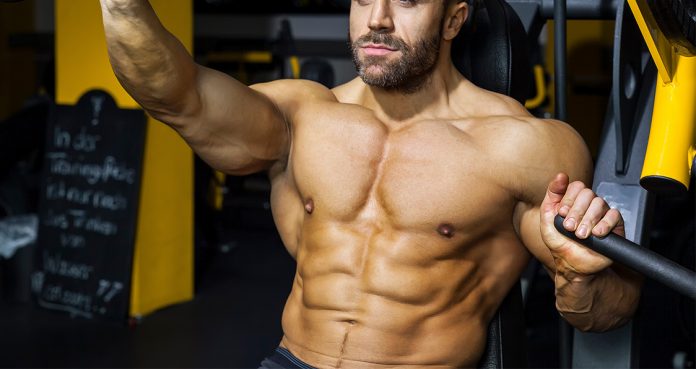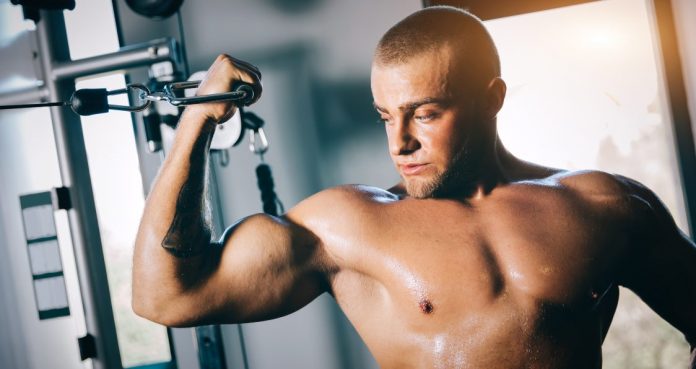Tag: pump

How To Get A Better Chest Day Pump
Tips for a Better Chest Day Pump
Almost all men who workout desire a wider chest. A broader and fuller chest can make you stand out of the crowd other than the fact that it adds a dash of masculinity to your personality.
A muscle pump is critical to the development of your muscles. The pump is when blood rushes to your working muscles and carries lactic acid and nutrients along with it. Developing your chest can be hard if you’re unable to recruit all your pectoral muscles during your workouts.
Pre-Exhaust Your Pecs
Most people start their chest workouts with the good old barbell bench press. While there is no denying the fact the bench press is a great exercise, performing an isolation exercise like the cable flyes can result in a better chest pump.
Performing the cable flyes at the beginning of your workouts will exhaust your pecs and you won’t have to lift as big weights as compared to what you would’ve to lift if you started off with the bench press.
Use a Pre-Workout Supplement
Pre-workout supplements can be incredibly effective in helping you get a pec pump during your workout. Pre-workout supplements have ingredients like nitric oxide, beta alanine, caffeine, beetroot extract, etc. which can help in achieving and amplifying muscles pumps.
Not only will the pre-workout supplement help you get a muscle-ripping pump but will also improve the quality of your workout by delaying fatigue, improving your focus and mind-muscle connection.
Add Isolation Exercises To The Mix
Compound (multi-joint) exercises like the bench or dumbbell presses are great at building muscle mass and strength. On the other hand, isolation (single-joint) exercises like pec deck fly, cables, chest machines are effective in getting you a better muscle pump and developing muscle conditioning.
Make sure you don’t rely too heavily on the isolation exercises as they might feel easier and quicker to perform. Maintain the right balance between compound and isolation movements to get the best of both worlds.
Increase Intensity and Change Rep Tempos
If you’ve been performing the 5 exercises of 3 set and 12 reps training routine and are not getting a muscle pump anymore, it’s time to spice things up. Pump your workout intensity by performing higher reps (15-20) to take your workouts to the next level.
Changing your rep tempos can also help in inducing better and nastier muscle pumps. An example of the rep tempos could be to slow down the negatives (eccentric movement) and fasten up the positive (concentric movement).
Use Advanced Training Techniques
Hitting a plateau can be one of the biggest factors for not getting a pump. Using advanced training techniques like the supersets, drop sets, intraset stretching, etc. can be an incredibly effective way of breaking through the overhead glass ceiling.
Try to incorporate at least one advanced training techniques in your workouts for getting a muscle-scorching pump. There are numerous training techniques to keep you entertained while ensuring muscle growth and development.
Which is your favorite chest exercise? Let us know in the comments below. Also, be sure to follow Generation Iron on Facebook and Twitter.

5 Ways To Boost Your Pump in the Gym
Get a Muscle Pump in the Gym
As bodybuilders and fitness enthusiasts, we’re always chasing a good pump in the gym. A muscle pump is the result of blood and lactic acid rushing into your muscles. Nothing can match the satisfactory feeling of leaving the gym with a muscle ripping pump.
For beginners, and advanced people alike, getting a muscle pump isn’t as simple as it might sound. A pump is essential to bodybuilding as it first tears the muscles down by expanding them and at the same time also helps in repairing by taking nutrients through blood.
1. Pre-Workout Supplements
Supplements are a big aid in bodybuilding. Pre-workout supplements containing nitric oxide can help you in achieving a muscle tearing pump. Nitric oxide might also help in improving your workouts by delaying fatigue and decreasing muscle soreness.
Pros use pre-workout supplements not only to get a pump but also to get a laser-sharp focus and improved strength and stamina. If you feel exhausted after a couple of sets into your workout, there is no way you can achieve a pump you can write home about.
One great pre-workout to consider is National Bodybuilding Co. Stage Ready Pre-Workout which won our GI Supplement Award for Best Pre-Workout. With highly researched and clinically dosed ingredients, this pre-workout has proven results with muscle pumps, cognitive focus, and intensity. A great pre-workout can boost your training and see huge muscle growth while giving solid energy and Stage Ready Pre-Workout is a great choice.
Check out GI Supplement Awards National Bodybuilding Co. Stage Ready Pre-Workout here.
You can also check out our official review guide of the best pre-workout supplements on the market right here.
2. Advanced Training Techniques
There are possibilities you might stop experiencing a pump after you’ve been working out for some time. If you’ve been following the same training program, chances are your muscles have adapted to it.
You need to spice up your workouts using advanced training techniques like supersets, drop sets, giant sets, rest-pause sets, etc. Changing up the tempos of your reps can also be incredibly useful as it will shock your muscles.
The next time you’re squatting, take three seconds on the way down, hold and pause at the bottom for two seconds, and blast up to the starting position in a second (3-2-1). You can also experiment with the tempos, for eg, (3-3-3), (1,1,2,), etc. Apply this technique to any and every exercise and be ready to get your mind blown by the pump.
For more advanced guides to exercises like the squat – check out our Bulgarian Squat guide right here to take your workout to the next level.
3. Mind-Muscle Connection
A lack of mind-muscle connection is one of the biggest reasons people don’t get a pump in the gym. Working out isn’t about going through the motions. The mind-muscle connection can be a problem, especially for the beginners.
If you’re doing a bicep curl, you need to ‘become’ your bicep. If you’re a beginner, looking at your biceps in the mirror will help you focus on your biceps. Squeeze and contract your guns at the top of the movement with every rep.
If you’re still having problems with establishing a mind-muscle connection, asking someone to gently tap on your biceps while you perform your exercises can help you in focusing on your pythons.
For more detailed information, check out our official guide with six ways to improve your mind-muscle connection.
4. BFR Training
Blood flow restriction (BFR) training will give you a pump you’ll remember for days. In BFR training, you tie elastic bands on your target muscles while performing your exercises. Doing this will let the blood enter your muscles but will delay the exit, giving you a mean pump.
You might need to increase the number of reps and slow down the movement, giving enough time for the blood to enter your muscles. Getting used to the BFR training can take some time as you need to get the tightness of the bands right, which can take a couple of tries.
5. Take it Easy
Sometimes people deprive themselves of a pump by trying too hard. You don’t need to lift super heavy or do too many reps to achieve a muscle altering pump. Doing 10 reps with a lightweight, proper form and squeezing the life out of your muscles with every rep can get you an insane pump.
Higher volume and intensity aren’t always the answers when it comes to making progress in the gym. Bodybuilding isn’t about lifting the most weight, it’s about putting the optimal amount of tension on your muscles, so they’re forced to grow, and getting a pump in your workouts can be a good indicator for it.
Recovery is also important as well. It’s the time your muscles repair and build back stronger. Check out our guide to the top 5 recovery tips right here.
When was the last time you had an insane pump in the gym? Let us know in the comments below. Also, be sure to follow Generation Iron on Facebook and Twitter.
